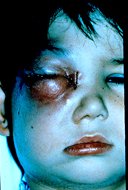Human Pythiosis
Human pythiosis insidiosi is characterized by the formation of subcutaneous lesions and the invasion of the main arteries. If not treated the infection is fatal. The majority of the cases have been diagnosed in Thailand. The disease has been also reported in Australia, Haiti, India, and the USA. The organism is acquired through traumatic implantation and remains localized or spreads to infect other tissues, especially arteries. The diagnosis of the disease in humans is based in culture, serology, and histopathology. In all cases hyphae of this oomycete are present in the infected tissues. Serological test such as ID and ELISA have proved to be of value for its early diagnosis.
Treatment of human subcutaneous pythiosis insidiosi on limbs, in which the arteries have been involved, consists of the amputation in the affected extremity. Iodides and other drugs have been used with questionable results. More recently the immunotherapeutic product used to treat equine pythiosis, was successfully used in at least two cases of human pythiosis. The immunotherapeutic product is being investigated for its possible use in new cases of human and animal pythiosis insidiosi.






